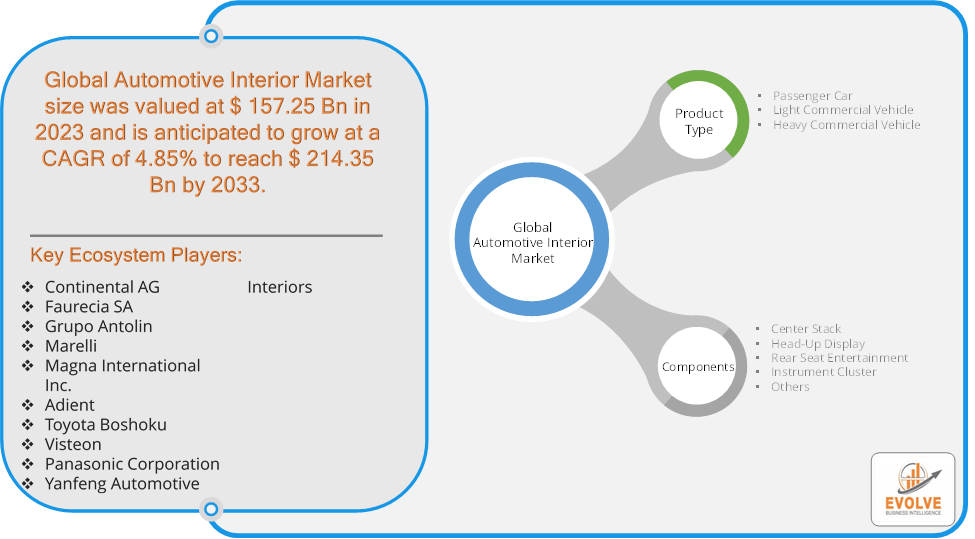Evolve Business Intelligence has published a research report on the Global Automotive Interior Market, 2023–2033. The global Automotive Interior Market is projected to exhibit a CAGR of around 4.85% during the forecast period of 2023 to 2033.
Evolve Business Intelligence has recognized the following companies as the key players in the global Automotive Interior Market: Continental AG, Faurecia SA, Grupo Antolin, Marelli, Magna International Inc., Adient, Toyota Boshoku, Visteon, Panasonic Corporation and Yanfeng Automotive Interiors.
 More Information: https://evolvebi.com/report/automotive-interior-market-analysis/
More Information: https://evolvebi.com/report/automotive-interior-market-analysis/
Market Highlights
The Global Automotive Interior Market is projected to be valued at USD 214.35 Billion by 2033, recording a CAGR of around 4.85% during the forecast period. The Automotive Interior Market refers to the industry segment that involves the production, distribution, and sales of components and systems used inside vehicles. This includes a wide range of products designed to enhance the comfort, aesthetics, safety, and functionality of a vehicle’s interior.
The market is influenced by factors such as consumer preferences for comfort and luxury, advancements in materials and technologies, regulatory requirements for safety, and trends towards connected and smart vehicle interiors.
The COVID-19 pandemic had a significant impact on the Automotive Interior Market. The pandemic caused major disruptions in the global supply chain. Many automotive interior component manufacturers faced delays due to factory shutdowns, restrictions on transportation, and shortages of raw materials. This affected the production schedules and delivery timelines of interior components. The pandemic increased consumer awareness and demand for health and hygiene features in vehicles. This led to the development and integration of new interior materials and technologies that are easy to clean and have antimicrobial properties. The economic downturn resulted in budget constraints for both consumers and manufacturers. Consumers became more cost-conscious, leading to a preference for vehicles with essential features rather than luxury interiors. Manufacturers faced financial challenges, impacting their investment in research and development for new interior technologies. The pandemic also highlighted the importance of sustainability. There was an increased focus on using eco-friendly materials and sustainable manufacturing practices in automotive interiors to meet consumer and regulatory demands.
Segmental Analysis
The global Automotive Interior Market has been segmented based on Product Type and Components.
Based on Product Type, the Automotive Interior Market is segmented into Passenger Car, Light Commercial Vehicle and Heavy Commercial Vehicle. The Passenger Car segment is anticipated to dominate the market.
Based on Components, the global Automotive Interior Market has been divided into Center Stack, Head-Up Display, Rear Seat Entertainment, Instrument Cluster and Others. The Rear Seat Entertainment segment is anticipated to dominate the market.
More Information: https://evolvebi.com/report/automotive-interior-market-analysis/
Regional Analysis
The Automotive Interior Market is divided into five regions: North America, Europe, Asia-Pacific, South America, and the Middle East, & Africa. North America region has high adoption of advanced infotainment systems, connected car technologies, and smart touch panels. Strong demand for luxury and premium vehicle interiors and increasing interest in health and wellness features, such as air purification systems and ergonomic seating. Increasing demand for seamless connectivity and advanced infotainment options and rising consumer awareness of health and hygiene, driving demand for antimicrobial materials and air quality control systems. Europe region is known for design innovation and premium vehicle segments. Countries like Germany and France are leading markets and opportunities to use recycled, biodegradable, and low-emission materials in automotive interiors. Asia-pacific region having strong growth in vehicle production and sales, driven by increasing disposable incomes and a rising middle class. Rising interest in modern, comfortable, and feature-rich vehicle interiors and rapid urbanization and increasing disposable incomes in countries like China and India are driving demand for new vehicles with advanced interiors and focus on cost-effective solutions and emerging markets. Latin America region is growing automotive industry with a focus on cost-effective solutions. Increasing consumer demand for modern and comfortable interiors and rising interest in advanced infotainment and connectivity features. In Middle East and Africa region, has emerging automotive markets with growing consumer demand. Focus on durability and performance due to challenging climatic conditions and increasing investments in automotive infrastructure and manufacturing.